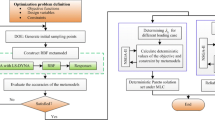Abstract
Tailor rolled blank (TRB) is an emerging steel rolling process to produce lightweight vehicle components. It allows continuous metal thickness changes, and as a result, it offers opportunities for automotive design in weight reduction, part complexity reduction, reduced capital investment, yet, maintains equal to or better strength characteristics. The objective of this research is to take advantages of the TRB manufacturing technology and combine with the advanced multidisciplinary design optimization (MDO) methodology to optimize vehicle structure. The process begins with noise vibration and harshness (NVH) optimization. The outputs of the optimal NVH response sensitivities are employed to build the first order response surface models. Uniform Latin Hypercube sampling and subset selection regression methods are used to construct the response surface models for the highly nonlinear impact and seatbelt pull responses. The optimal NVH design is then used as the starting point for MDO to obtain the optimal thickness profiles for the TRB parts. A vehicle application considering multiple impact modes, seatbelt pulls, and NVH, is used to demonstrate the proposed process for vehicle underbody TRB design. Results of this MDO TRB study is presented and discussed.
Similar content being viewed by others
References
Chatti S, Heller B, Kleiner M, Ridane N (2002) Forming and further processing of tailor rolled blanks for lightweight structures. Adv Technol Plasticity 2:1387–1392
Fang K, Lin D, Winker P, Zohang Y (2000) Uniform design: theory and application. Technometrics 42:237–248
Glad M, Muller-Bechtel M (2005) Thickness optimization as a tool for evaluation of structures. NAFEMS Seminar: optimization in structural mechanics, Wiesbaden, Germany
Gu L, Yang RJ (2006) On reliability-based optimization methods for automotive structures. Int J Mater Prod Technol 25, Nos. 1/2/3
Gu L, Yang RJ, Tho C, Makowski M, Faruque O, Li Y (2001) Optimization and robustness for crashworthiness of side impact. Int J Veh Des 26:348–360
Hoope A, Kaufmann M, Lauber B (2005) Multidisciplinary optimization considering crash and NVH loadcases. ATZ/MTZ Virtual Product Creation
Kleiner M, Geiger M, Klaus A (2003) Manufacturing of lightweight components by metal forming. ANNALS-CIRP 52:521–542
Kodiyalam S, Yang RJ, Gu L, Tho C (2002) Large scale multidisciplinary optimization of a vehicle system in a scalable, high performance computing environment. DETC/DAC-21082, Pittsburg
McKay MD, Bechman RJ, Conover WJ (1979) A comparison of three methods for selecting values of input variable in the analysis of output from a computer code. Technometrics 21:239–245
Miller AJ (1990) Subset selection in regression. Chapman & Hall, London
Mullerschon H, van den Hove M, Mlekiusch B (2006) Optimization strategies for highly non-linear FE-applications as crashworthiness. European conference on computational mechanics solids, structures and coupled problems in engineering, Lisbon, Portugal
National Highway Traffic Safety Administration Federal Motor Vehicle Safety Standards (1999) Standard No. 207-seating systems and standard No. 201-seat belt assembly anchorages. Washington, DC
Redhe M, Nilsson L (2004) Optimization of the new Saab 9-3 exposed to impact load using a space mapping technique. Struct Multidiscipl Optim 27:411–420
Rehse M (2006) Flexible rolling technologies (Tailor Rolled Blanks). Great designs in steel
Sener JY, De Medeiros C, Lescart JC, Marron G, Antoine P, Delfanne S (2002) Increasing performances by using multi-thicknesses blanks. SAE2002-01-2087
Sobieski JS, Kodiyalam S, Yang RJ (2001) Optimization of car body under constraints of noise, vibration, and harshness (NVH), and crash. Struct Multidiscipl Optim 22:295–305
Yang RJ, Gu L (2003) Experience with approximate reliability-based optimization methods. Struct Multidiscipl Optim 25:1–9
Author information
Authors and Affiliations
Corresponding author
Rights and permissions
About this article
Cite this article
Chuang, C.H., Yang, R.J., Li, G. et al. Multidisciplinary design optimization on vehicle tailor rolled blank design. Struct Multidisc Optim 35, 551–560 (2008). https://doi.org/10.1007/s00158-007-0152-0
Received:
Revised:
Accepted:
Published:
Issue Date:
DOI: https://doi.org/10.1007/s00158-007-0152-0




